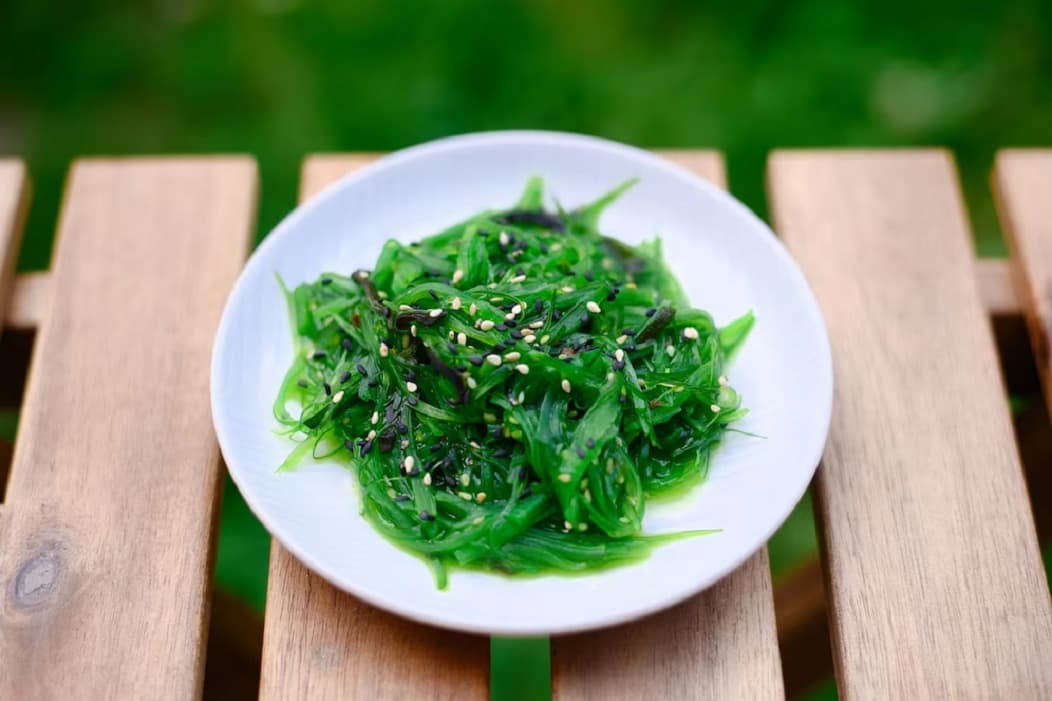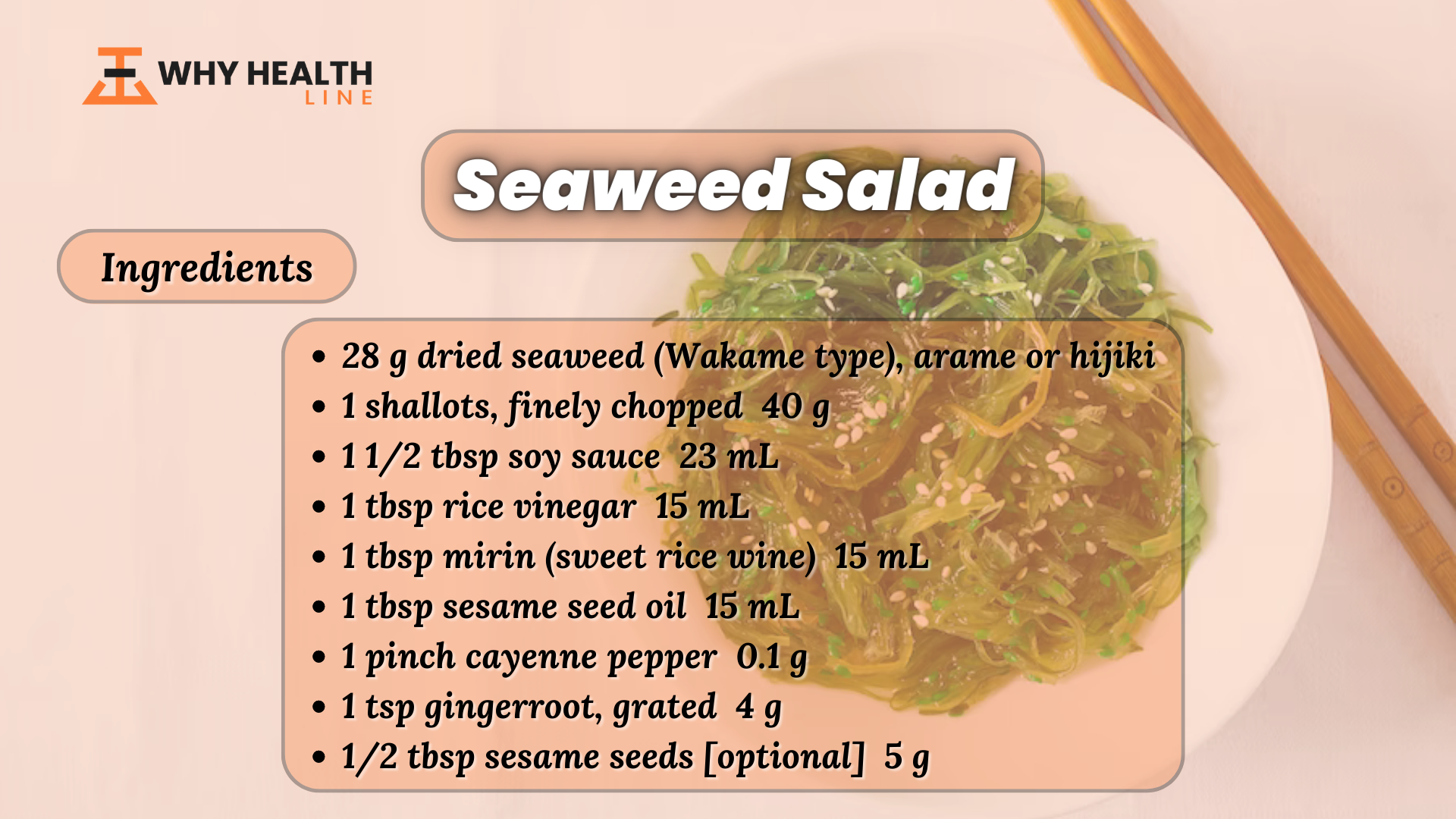Seaweed salad is a dish that has become quite popular in Western countries. However, it is commonly served in Japanese and Korean restaurants and is made from wakame seaweed, which is highly nutritious and comprises numerous health benefits.
This salad is an excellent source of vitamins, fiber, and minerals that may contribute to supporting heart health, managing hypertension, and promoting weight loss. This article aims to provide useful information about this incredible dish, so continue with your reading!
Nutritional Profile of Seaweed Salad
When you indulge in a delicious seaweed salad, it can deliver an abundance of vital nutrients that are essential for the proper functioning of your body. A mere cup of raw wakame seaweed usually contains 36 calories, 0.5 grams of fat, 0.5 grams of natural sugars, and 7.3 grams of carbohydrates.
Varieties of Seaweed Salad
There are hundreds of different seaweed in the world’s oceans, and each of them has a unique color and texture. That’s why seaweeds are also characterized as sea veggies.
Below are some of the most popular seaweed salad options enjoyed globally.
-
Dulse
On our list, the first type of sea vegetable is dulse, which is a red seaweed with deep red or purplish fronds and a palm-like shape. It grows in the cool waters of the Northern Atlantic and Arctic oceans.
Dulse is often hailed as an excellent bacon alternative due to its salty and savory flavor. If you’re looking for a tasty and crispy snack, try pan-frying some dulse flakes. You can also use dulse as an ingredient in sandwiches or salads for a delicious and nutritious addition.
-
Nori
Nori is another popular variety of seaweed. It is a type of dried seaweed that goes through extensive processing before it becomes part of your salad. The nori fronds go through a careful farming procedure before being shredded, washed, and mixed with fresh water.
The resulting mixture is then pressed and toasted into sheets using a machine and toasted. These sheets look like paper but are actually quite healthy.
-
Arame
Arame is a variety of brown seaweed that is typically harvested from clean waters. Its leaves are cut into pieces and dried. They are sold in the form of thin, black noodles. Arame has a gentle, somewhat sweet flavor and can be included in stir-fries, noodle dishes, and salads.
Health Benefits of Seaweed Salad
Seaweed salad, with its vibrant colors and tangy flavor, is the perfect addition to any meal. Many consider seaweed a superfood thanks to its high nutrient content and potential health benefits.
- Good Source of B12: Seaweed is an excellent source of vitamins and is considered a good option for vegetarians.
- Filled with Vitamin K: Seaweed salad is packed with vitamin K vitamin which is extremely beneficial for blood clotting.
- Weight Control: Seaweed salad is high in fiber and relatively low in fat, making it a perfect dish for weight loss.
- Improves Heart Health: Seaweed contains nutrients that have the potential to lower blood pressure and promote better heart health.
Potential Downside of Seaweed Salad
Seaweed salad is an extremely healthy and safe dish to have. But remember that moderation is crucial. While seaweed can be a great addition to your diet, consuming high amounts or adding it to every salad might not be good.
Excessive quantities of seaweed contain high levels of iodine. Although most people can tolerate high levels of iodine, some individuals may be more prone to its effects, which can lead to issues like hyperthyroidism.
How To Make a Seaweed Salad
In order to prepare a seaweed salad, the first thing you need to do is to soak the dried seaweed in a bowl of water until it becomes completely hydrated.
Typically, this takes around 6 to 7 minutes, but thicker parts of the seaweed may require additional time for the moisture to fully penetrate. It’s important not to over-soak the seaweed, as this can cause it to become mushy and dilute the dressing.
After soaking seaweed in water, place it on a cutting board and chop it into rough 1/2-inch slices. Then, add the seaweed in a mixture of oil, vinegar, sugar, and salt, adjusting the seasonings to your taste preference.
In the end, sprinkle sesame seeds and serve the dish cold or at room temperature. If you have any remaining seaweed, you can store it in the refrigerator for up to 2 to 4 days.
Is Seaweed Healthy?
Conclusion
Seaweed is a widespread ingredient used in many cuisines worldwide, most commonly in salads. It’s an excellent source of iodine, which helps your thyroid gland function properly.
Seaweed also contains other essential vitamins and minerals like vitamin K, B vitamins, zinc, and iron. It’s also rich in antioxidants that protect your body’s cells from damage.
However, excessive consumption of iodine from seaweed may harm your thyroid. Therefore, to benefit from this incredible ingredient, it’s best to consume it in relatively moderate amounts.
FAQs:
What Does Seaweed Taste Like?
Seaweed has a slightly salty taste and can have either a crunchy or rubbery texture. When roasted and seasoned, it offers a deliciously crispy flavor with an enticing balance of sweetness and saltiness.
Is Seaweed Salad Good For You?
Seaweed salad is a superfood and is considered a powerhouse for micronutrients. It may help boost your immune system, helping you fight off viruses. Plus, seaweed is also a great source of iodine, which your body needs to make thyroid hormones.
Is It OK To Eat Seaweed Salad Every Day?
Even though the levels of risk may be low, eating seaweed salad on a daily basis may lead to the gradual accumulation of toxic metals in the body. Therefore, it is always a good idea to make sure that the seaweed is completely organic and obtained from a high-quality source.



